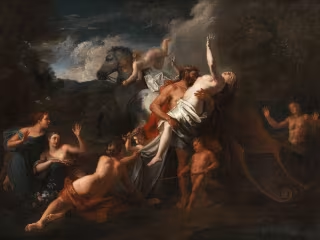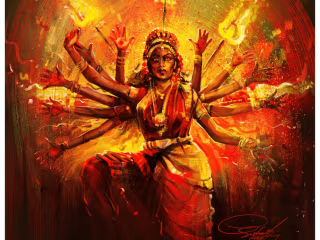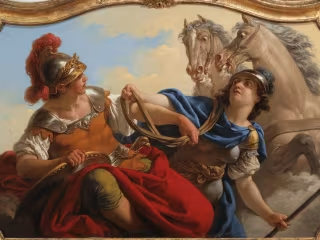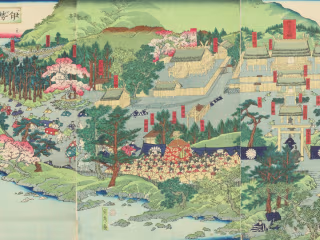Inari: The God/Goddess Of Prosperity, Rice, And Agriculture
0
Ghostwriter
Blog Writer
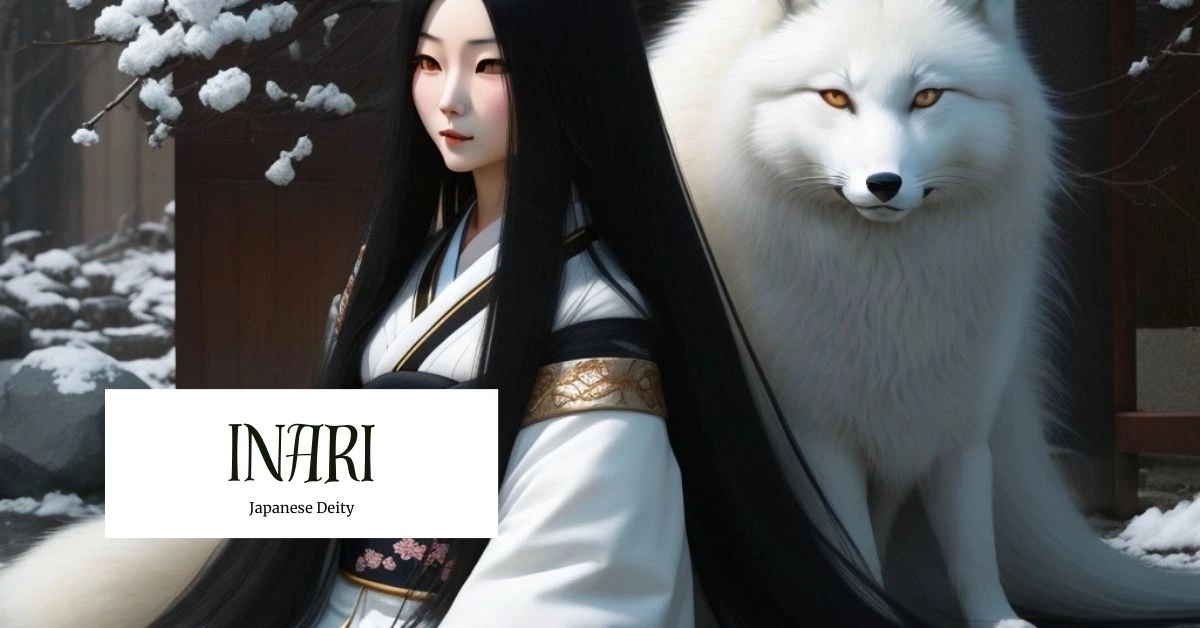
In the rich tapestry of Japanese mythology and culture, one deity stands out above all others – Inari, the divine patron of prosperity, rice, and agriculture. The revered figure Inari is honored through lively festivals and takes on both male and female forms, each with its unique names, attributes, and symbols that reflect their intricate nature and divine abilities. From Inari’s origins in ancient lore to their role in saving Japan from famine, Inari has earned a place of honor and reverence, with more shrines dedicated to their worship than any other kami in Japan.
Overview of Inari
Inari is a revered god/goddess in Japanese mythology, deeply ingrained in the country’s agricultural heritage. The goddess of prosperity takes many names, such as Ō-Inari, Ukanomitama-no-kami, and Omiyanome-no-kami. Inari is rooted in the word ine, meaning rice seedling, and translates to ‘rice carrier’ (“Inari”). Inari’s influence extends to the prosperity of farmers and merchants, serving as a guardian deity who protects crops from harm and ensures bountiful yields for their devoted followers. To this day, Inari’s legacy carries on as the deity remains highly respected and celebrated in Japanese culture.

Source: Aminoapps
Titles
The Queen of Rice Fields
Patroness of Farmers and Merchants
Goddess of Prosperity and Abundance
Bringer of Fertility and Wealth
Guardian of Agriculture and Grain
Abilities
According to ancient Japanese folklore, Inari, the patron god/goddess of agriculture and prosperity, possesses many divine powers. Among these abilities, Inari has the power to bestow bountiful harvests, bring financial success, and safeguard agricultural endeavors against misfortune and disasters. Furthermore, Inari’s influence extends beyond agriculture, as Inari possesses healing powers capable of curing many afflictions, including coughs, toothaches, broken bones, and syphilis (“Inari – New World Encyclopedia”).
Characteristics
In Japanese illustrations, the deity Inari takes diverse forms, including male and female representations. Scholar Karen Ann Smyers reports that the most widespread depictions of Inari are those of a youthful female food goddess, an elderly male carrying rice, and an androgynous bodhisattva. It is essential to note that no one form of depiction is incorrect, as gender preference varies depending on regional traditions and individual beliefs. Notably, Inari is extensively associated with kitsune, the fox, symbolizing their affiliation with the spiritual realm. As a result, many illustrations of Inari typically feature foxes (“Inari”).

Source: Wattpad
Traits
Inari embodies many positive qualities, including generosity, empathy, and nurturing nature, all of which contribute to the well-being and prosperity of their devoted followers. Inari is celebrated for their unwavering kindness towards humanity and fiercely protects and supports those who worship them. The god/goddess’s commitment to the betterment of their worshippers is a testament to Inari’s divine power and influence.
Symbols
Inari is a prominent figure in Japanese folklore, and their attributes and influence are often visually represented through various symbols. One of the most well-known symbols of Inari is the fox, or kitsune, which is a supernatural creature in Japanese mythology. Kitsune is a messenger or divine familiar (“Inari”), and it is no surprise that this creature is associated with Inari, as the deity is a protector of agriculture and fertility.
Another symbol commonly associated with Inari is rice, as they are known as The Queen of rice fields. Rice bags are a significant symbol representing Inari’s connection to agriculture and rice cultivation. Offering these items to Inari is seen as a sign of devotion and a desire for abundance. Additionally, torii gates are another important symbol that is associated with Inari. These gates are at the entrance of Shinto shrines dedicated to Inari and represent the boundary between the human world and the spiritual realm.
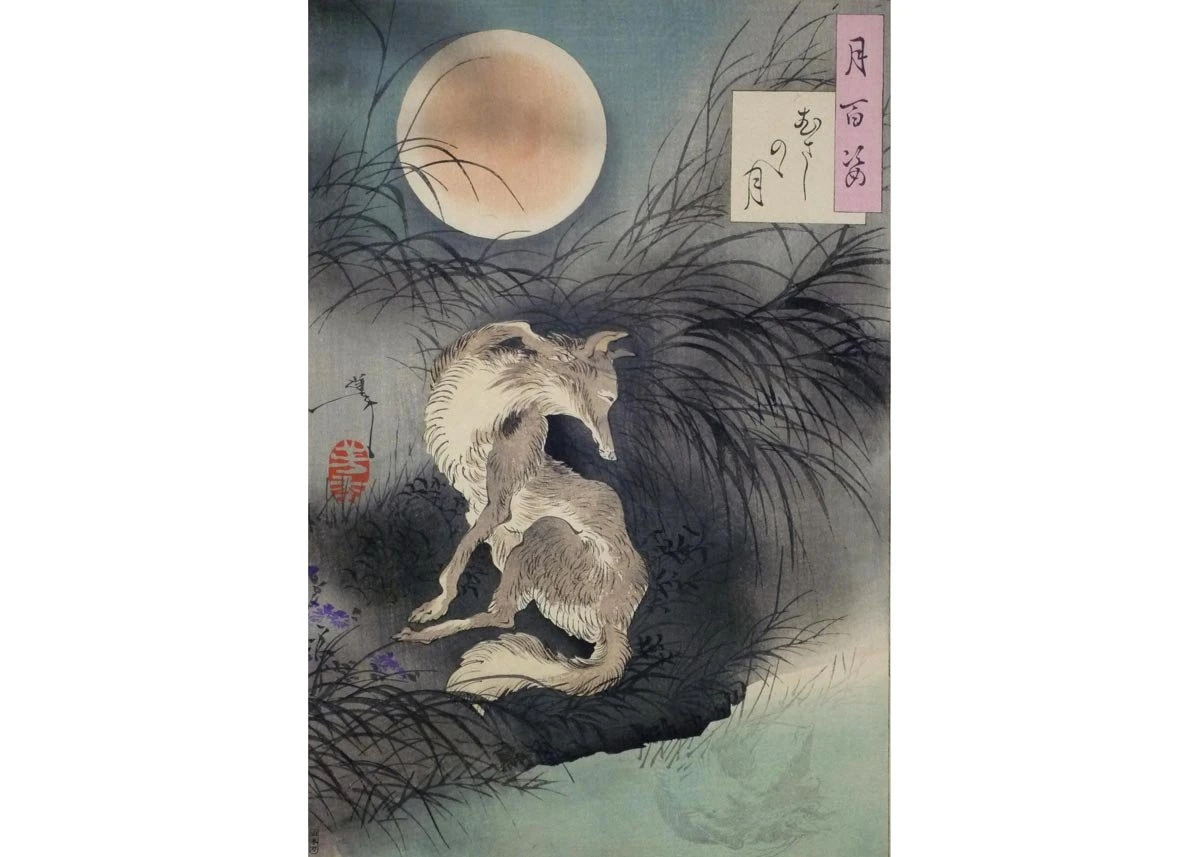
Source: Japanobjects
Festivals and Rituals
The worship of Inari is deeply ingrained in Japanese culture and consists of a series of vibrant festivals and rituals held throughout the year. Across Japan, there are over 40,000 shrines dedicated to the god, ranging from small local shrines to grand, elaborate structures. Perhaps the most famous of these is the Fushimi Inari Shrine near Kyoto. The shrine is considered the oldest and most important shrine dedicated to Inari. Here, visitors can marvel at the shrine’s impressive red torii gates and fox statues, which honor the animal that serves as Inari’s messenger and guardian (“Inari”).
One of the most highly anticipated events in the Inari worship calendar is the O-Inari-san Festival, which takes place annually at the Fushimi Inari Taisha in Kyoto. Devotees gather from all over the country to pay homage and offer prayers to Inari, seeking blessings for prosperity, business success, and good fortune. The festival includes an array of intricate rituals, including the presentation of rice, sake, and symbolic items, as well as expressions of gratitude and requests for favor from Inari.
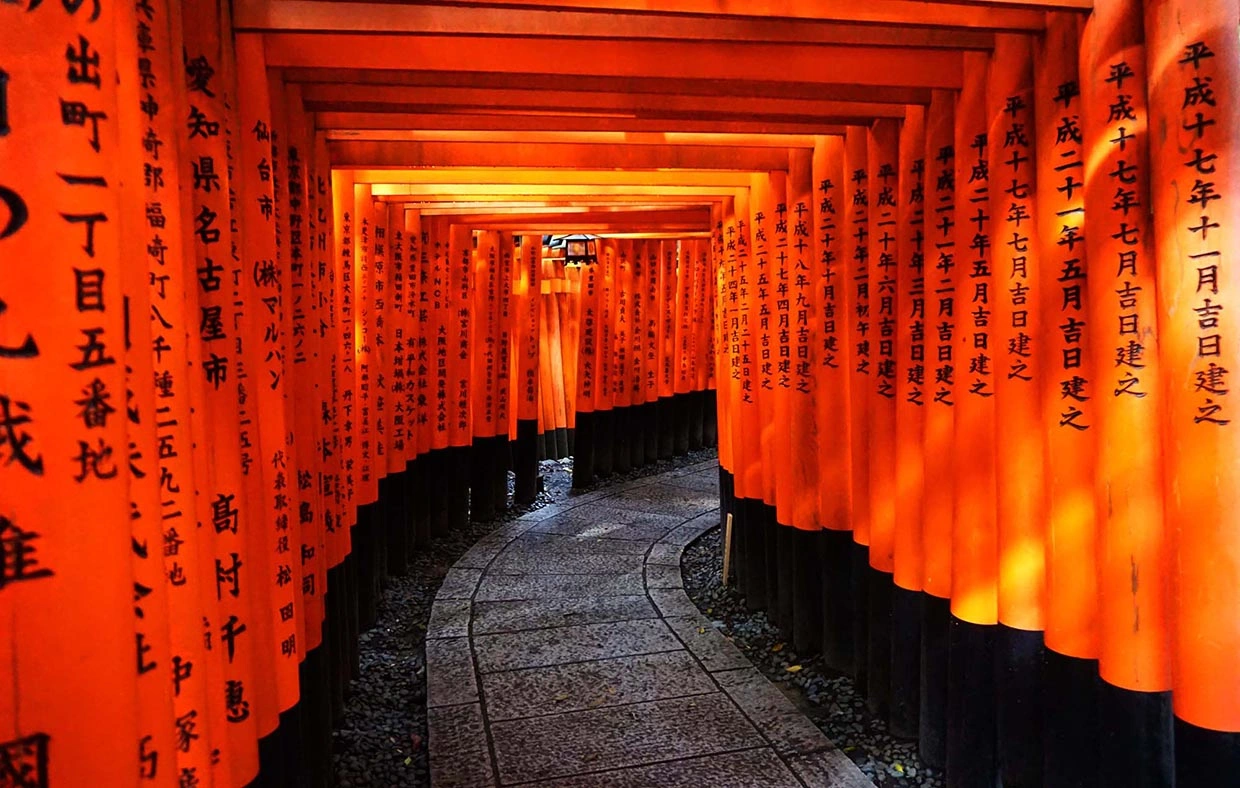
Source: Omamori
Legends associated with Inari
The revered deity Inari, whose influence extends to prosperity and agriculture, has an intriguing history filled with captivating legends. The legends passed down over generations provide a window into the mystical origins of Inari. By connecting Inari to Japan’s cultural and spiritual heritage, these stories deepen our understanding of the deity and their significance.
Origin story
The origin of Inari has been a topic of interest among various sources and folklore. One prevalent account suggests that Inari was born from the divine union of the gods Izanagi and Izanami. According to this myth, Inari emerged alongside her siblings as part of the pantheon of Shinto deities, representing fertility, agriculture, and prosperity.
Another variation proposes that Inari was first worshiped on Mount Inari in the 8th century following an intriguing discovery by a man named Hata no Irogu. As the story goes, Irogu was practicing his archery skills using sticky rice cakes (mochi) as targets when one of his shots hit directly through a cake, which magically transformed into a white dove. Fascinated, Irogu followed the bird, which landed on a peak of Mt. Inari called Mitsumine. There, he discovered rice growing and began to worship Inari as a spirit or Shinto kami, seeing Inari as the deity of rice, agriculture, and prosperity (“Inari”).
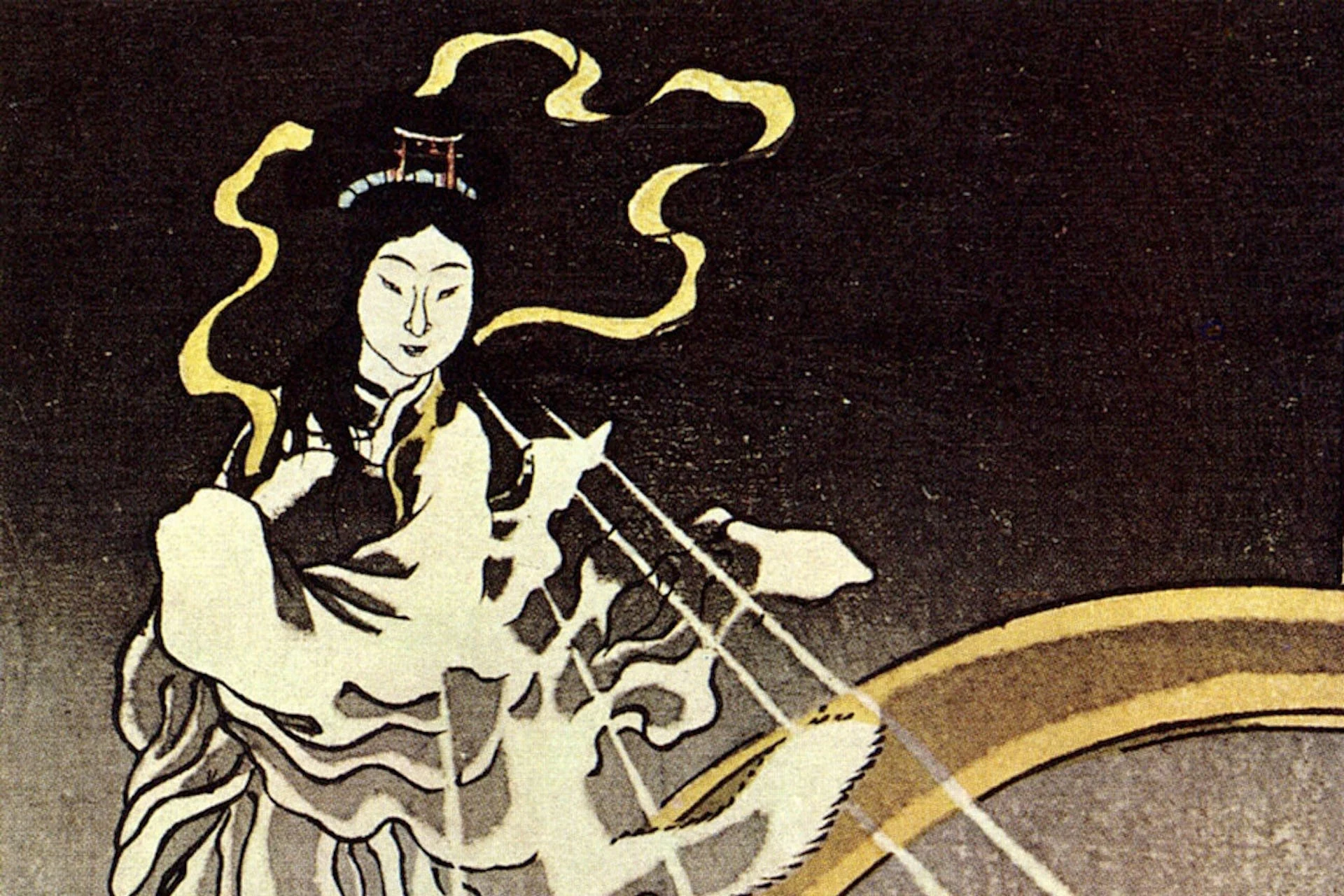
Source: Mythopedia
Saving Japan From Famine
According to legend, Inari descended from the heavens down to Japan during a great famine. As Inari rode a magnificent white fox, Inari carried sheaves of cereal or grain. Interestingly, the term “Ine,” used today to refer to rice, was the name of the cereal that Inari brought with them. This cereal was not rice but grain that grew in swamps. According to the legend, during ancient times, Japan was mostly swamp and water land, which makes it all the more fascinating to imagine the scene of Inari arriving on their white fox, bearing the gift of life-giving cereal (Wikipedia Contributors).
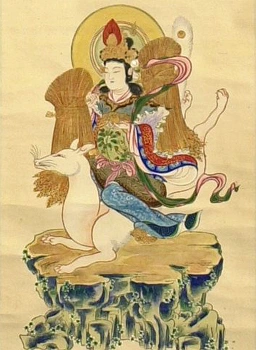
Source: Japanesemythologyblog
Influences of other religions/cultures on Inari
Throughout history, Inari’s veneration has been shaped and influenced by the syncretism of religious practices adopted over time. Of particular note is the introduction of Buddhism to Japan, which impacted the perception and recognition of Inari. This impact led to establishing Buddhist temples and statues close to Inari shrines, resulting in a fusion of beliefs and blurring the lines between the two. Over time, Inari became increasingly associated with the Buddhist figure Dakiniten, the goddess of harvest and fertility (Wikipedia Contributors). This association expanded Inari’s role and attributes and cemented their place in Japan’s cultural and spiritual landscape.
Modern appearances
In contemporary media, Inari is a popular character in manga, anime, and video games, often symbolizing wealth and good fortune. One example is the Persona series, a spinoff of the larger Megami Tensei video game franchise. In the game, Yusuke Kitagawa (inspired by Inari) dons a fox mask and tail (“Inari”).

Source: Persona records
In the World of Darkness role-playing game universes, kitsune, the legendary fox spirits, are present in both the classic World of Darkness and the follow-up Chronicles of Darkness. In the latter, kitsune are changing breeds whose unique abilities are bestowed upon them by Inari (“Inari”).
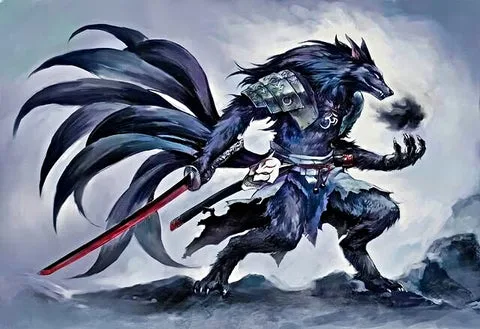
Source: Japaneseonimasks
Final thoughts
The god/goddess Inari is highly esteemed among the Japanese people. Their story is steeped in legend, featuring mystical fox messengers and a magical rice sack, which illustrate Inari’s role as a provider of prosperity and protector of agriculture. As various religious practices and Buddhism merged, Inari’s significance evolved and changed because of the development of new customs. Even today, Inari’s cultural importance extends beyond ancient traditions and remains relevant in contemporary contexts, showcasing the enduring influence of this venerated deity.
References
“Inari.” World History Encyclopedia, www.worldhistory.org/Inari/.
“Inari.” Mythopedia, mythopedia.com/topics/inari.
“Inari – New World Encyclopedia.” Www.newworldencyclopedia.org, www.newworldencyclopedia.org/entry/Inari.
Wikipedia Contributors. “Inari Ōkami.” Wikipedia, Wikimedia Foundation, 27 Dec. 2019, en.wikipedia.org/wiki/Inari_%C5%8Ckami.
Did we miss something? Do you know another aspect of this legend? Don't hesitate to reach out!
Like this project
0
A client hired me to write several informative pieces on Japanese Goddesses, and this blog post centers around the Goddess of Prosperity and Agriculture, Inari.
Likes
0
Views
1564
Tags
Ghostwriter
Blog Writer


